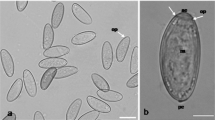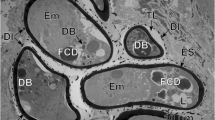Summary
The egg of Fasciola hepatica has a smooth surface with a slightly elevated circle marking the fracture of the operculum. The operculum and the aperture have crenated edges.
The epithelial cells of the miracidium are covered with long cilia. When miracidia are vibrated in an ultrasonic cleaner the cilia of the epithelial cells of the four posterior tiers are broken off only leaving longitudinal rows of cilium stubs, whereas the cilia of the first tier are still retained.
The apical papilla is provided with a dorso-ventral furrow, multiciliated pits and isolated sensory cilia. The narrow intercellular ridge is smooth, whereas the epithelial cells have small cytoplasmic knobs between the cilia.
The penetration into the snail (Lymnaea truncatula) and the transformation into sporocyst may be separated into three phases. (1) Less than 1 min after attachment to the snail the ciliated cells of the anterior tier are shed and swim away. (2) The cilia of the remaining cells beat violently and after about 5 min most cilia are broken off near the cell surface. The miracidium remains for about 15 min embedded as far as the intercellular ridge receptors (lateral papillae and sheathed ciliated nerve endings). During this period extensive contraction and relaxation of the body are performed. (3) The final penetration of the snail epithelium takes about 15 min. Simultaneously with the penetration into the snail tissue the “bald” cells (epithelial cells with cilium stubs only) of the four posterior tiers loosen, form globules and fall off. The surface below the cells is smooth and in cytoplasmic continuity with the intercellular ridge and the apical papilla, and this syncytium forms the later tegument of the sporocyst. After a few days the tegument of the sporocyst is provided with microvillus-like projections and the apical papilla and sensory structures are lost.
Similar content being viewed by others
Abbreviations
- AP:
-
apical papilla
- C:
-
cilium or cilium stub
- CN:
-
ciliated nerve ending
- CP:
-
ciliated pit
- EP:
-
Excretory pore
- IR:
-
intercellular ridge
- LP:
-
lateral papilla
- SC:
-
sheathed ciliated nerve ending
- 1, 2, 3, 4, and 5:
-
epithelial cell in tier No. 1, 2, 3, 4, and 5 respectively
References
Brooker, B.E.: The sense organs of trematode miracidia. In: E.U. Canning and C. A. Wright, eds., Behavioural aspects of parasite transmission. Zool. J. Linn. Soc. 51, Suppl. 1, 171–180 (1972)
Campbell, W.C., Todd, A.C.: In vitro metamorphosis of the miracidium of Fascioloides magna (Bassi, 1875) Ward, 1917. Trans. Amer. micr. Soc. 74, 225–228 (1955)
Coe, W.R.: Notizen über den Bau des Embryos von Distomum hepaticum. Zool. Jb., Abt. Ant. u. Ontog. 9, 561–570 (1896)
Dawes, B.: A study of the miracidium of Fasciola hepatica and an account of the mode of penetration of the sporocyst into Limnaea truncatula. Libro Homenaje al Dr. Edwardo Caballero y Cabellero, pp. 95–111. Mexico: Escuela National de Ciencias Biologicas 1960
Erasmus, D.A.: The biology of trematodes. London: Edward Arnold 1972
Køie, M., Frandsen, F.: Stereoscan observations of the miracidium and early sporocyst of Schistosoma mansoni. Z. Parasitenk. 50, 335–344 (1976)
Mattes, O.: Wirtsfindung, Invasionsvorgang und Wirtsspezifität beim Fasciola-Miracidium. Z. Parasitenk. 14, 320–363 (1949)
Nansen, P., Frandsen, F., Christensen, N.Ø.: A study on snail location by Fasciola hepatica using radioisotopically labelled miracidia. Parasitology 72, 163–171 (1976)
Saint-Guillain, M.: Étude histologique des primiers stades evolutifs de Fasciola hepatica L. Acta zool. path. (Antwerp.) 46, 77–132 (1968)
Soutgate, V.R.: Observations on the epidermis of the miracidium and on the formation of the tegument of the sporocyst of Fasciola hepatica. Parasitology 61, 177–190 (1970)
Thomas, A.P.: The life history of the liver fluke Fasciola hepatica. Quart. J. micr. Sci. 23, 99–133 (1883)
Wilson, R.A.: Fine structure of the tegument of the miracidium of Fasciola hepatica L. J. Parasit. 55, 124–133 (1969a)
Wilson, R.A.: Fine structure and organisation of the musculature in the miracidium of Fasciola hepatica. J. Parasit. 55, 1153–1161 (1969b)
Wilson, R.A.: Fine structure of the nervous system and specialized nerve endings in the miracidium of Fasciola hepatica. Parasitology 60, 399–410 (1970)
Wilson, R.A.: Gland cells and secretions in the miracidium of Fasciola hepatica. Parasitology 63, 225–231 (1971)
Wilson, R.A., Pullin, R., Denison, J.: An investigation of the mechanism of infection of the miracidia of Fasciola hepatica into its snail host Lymnaea truncatula. Parasitology 63, 491–506 (1971)
Wright, C.A.: Flukes and snails. London: George Allen and Unwin 1971
Author information
Authors and Affiliations
Rights and permissions
About this article
Cite this article
Køie, M., Christensen, N.Ø. & Nansen, P. Stereoscan studies of eggs, free-swimming and penetrating miracidia and early sporocysts of Fasciola hepatica . Z. F. Parasitenkunde 51, 79–90 (1976). https://doi.org/10.1007/BF00380530
Received:
Issue Date:
DOI: https://doi.org/10.1007/BF00380530




